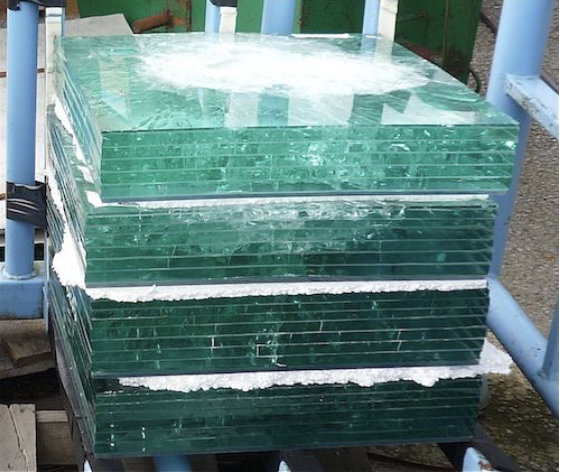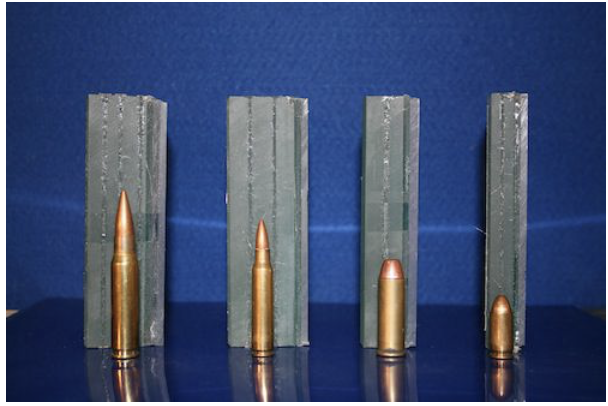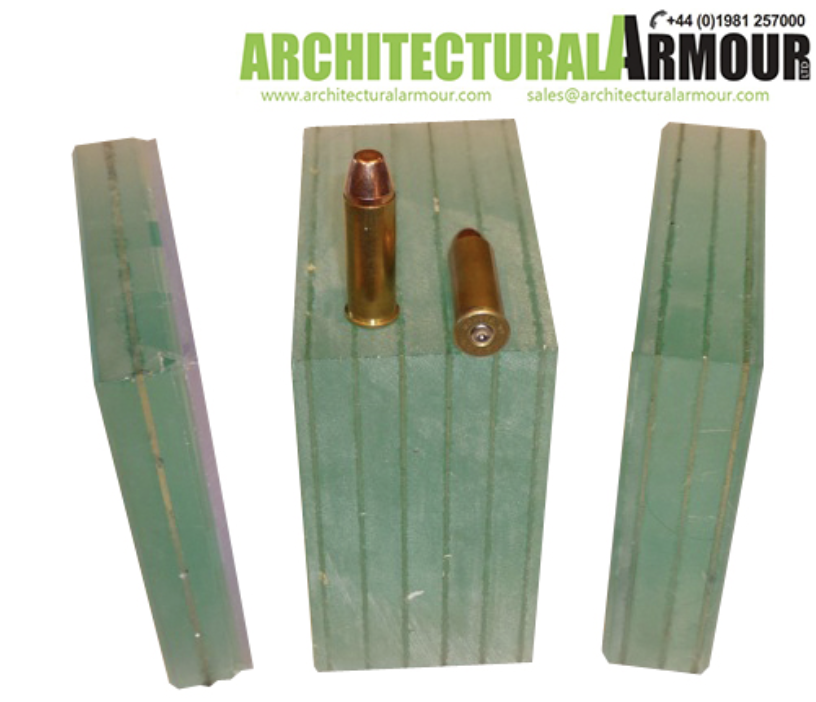HOW TO CHOOSE A BULLET GLASS
 When selecting a bullet glass there are a number of variables to
When selecting a bullet glass there are a number of variables to
consider, these include the level of protection, the composition of the glass and the spall variant , the following aims to give some insight into the options available.
LEVEL OF PROTECTION
Bullet or Ballistic glass is predominantly manufactured to meet test criteria which are applied worldwide by national standards agencies. These technical performance specifications require a set number of test samples to withstand impacts from a range of bullets travelling at specified speeds, from set distances.
To be successful all of the samples must prevent the penetration of the bullet from attack face to secure side.
Within the UK the most commonly specified standards are the European BS EN 1063 levels BR2, BR3, BR4, BR5, BR6 & BR7 and British BS 5051 , levels GO, G1, G1S, G2, G2S86, R1 & R2.
Internationally the US NIJ 0108.01 and UL752 are commonly specified.
Generally they are similar in that they all include tests to defeat the weapons using a variety of bullets including armour piercing rounds.
![]() 9mm Luger
9mm Luger
![]() .357 Magnum
.357 Magnum
![]() .44 Magnum
.44 Magnum
![]() 5.56 x 45 Rifle
5.56 x 45 Rifle
![]() 7.62 x 51 Rifle
7.62 x 51 Rifle
BULLET GLASS COMPOSITIONS
Bullet glass compositions vary but most common are laminated  structures manufactured from several layers of glass bonded together with tough polyvinyl butyral (PVB) interlayer’s. The performance requirements govern the number, and thickness of individual glass layers, thus affecting the overall thickness and weight. On impact the front layers of glass are designed to absorb the bullets initial impact energy by shattering allowing the subsequent glass layers and PVB to absorb the lower level shock waves.
structures manufactured from several layers of glass bonded together with tough polyvinyl butyral (PVB) interlayer’s. The performance requirements govern the number, and thickness of individual glass layers, thus affecting the overall thickness and weight. On impact the front layers of glass are designed to absorb the bullets initial impact energy by shattering allowing the subsequent glass layers and PVB to absorb the lower level shock waves.
Some bullet compositions include the use of a polycarbonate layer on the secure side, the advantages of this are two fold. Polycarbonate is lighter and stronger than glass and its use allows the manufacturers to reduce overall thickness and greatly reduce weight, especially in no spall variants.
SPALL OPTIONS
Spall is the material ejected from the rear surface of a bullet resistant glass when the attack face is struck by a projectile. The ejection of spall does not mean the bulletproof glass has failed, as long as the bullet or any bullet fragments have not penetrated to the secure side. For this reason bullet glass is normally specified in 3 categories.
Spall Allowed, which is only appropriate when personnel are not within close proximity.
Low, Reduced or Minimum Spall, where the traveling distance of spall is restricted.
No Spall, where no spall can be ejected after impact.

All 3 bullet composistions shown above are certified to BS 1063 BR4, capable of stoping multiple shots from a .44 Magnum.
The left pane is 24 mm Glass Polycarbonate and offers the same No Spall protection as the 58 mm All Glass pane shown centrally.The Polycarbonate weighs 52 kg/m2 compared to the 140kg/m2 of the all glass.
The right hand pane is an All Glass Spall Allowed product at 32mm thick weighing 75kg/m2.
Spall Allowed and No Spall are clasifications in BS EN 1063, Low Spall is more commonly associated with BS 5051 and is often used in compositions for bullet catogories G0, G1, G1S and G2S86.
The above is not an exhaustive list, and when choosing the correct bullet glass there are many other considerations which may have a bearing in the final design, such as maximum pane size available, the requirement for low iron or cost.
bs-en-1063To help select the correct product for you we advise you to contact us for further discussion.
